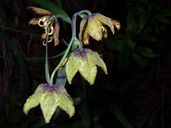Taxon Report
Fritillaria ojaiensis A. Davids.Ojai fritillary |
 © 2010 David Magney |
Taxon Summary
Fritillaria ojaiensis, commonly known as Ojai fritillary, is a perennial bulbiferous herb in the Liliaceae that is found only in California. It occurs within Broadleafed upland forest (mesic), Chaparral, Cismontane woodland, and Lower montane coniferous forest, growing at elevations from 225 to 998 meters. Fritillaria ojaiensis is ranked 1B.2, Plants Rare, Threatened or Endangered in California and Elsewhere; Moderately threatened in California.Classification
|
Scientific Name: |
Fritillaria ojaiensis A. Davids. |
|
Common Name: |
Ojai fritillary |
| Family: | Liliaceae |
| Element Code: | PMLIL0V0N0 |
| USDA Plants Symbol: | FROJ |
|
Synonyms/Other Names: |
|
Ecology and Life History
| Lifeform: | perennial bulbiferous herb |
| Blooming Period: Feb-May | Feb-May |
| Elevation: | 225-998 (740-3275) |
| General Habitats: | Broadleafed upland forest, Chaparral, Cismontane woodland, Lower montane coniferous forest |
| Microhabitat: | Rocky |
| Microhabitat Details: |
Conservation Status
| CA Rare Plant Rank: | 1B.2 |
| Global Rank: | G3 |
|
State Rank: |
S3 |
| State List: | None |
| Fed List: | None |
| Other Status: | BLM_S; SB_SBBG; USFS_S |
|
CRPR Changes: |
|
Occurrence Data from the CNDDB
| Total Occurrences: | 49 |
| Element Occurrence Ranks: | |
| Excellent (A) | 2 |
| Good (B) | 10 |
| Fair (C) | 1 |
| Poor (D) | 1 |
| None (X) | 0 |
| Unknown (U) | 35 |
| California Endemic: True | |
| California Counties and Islands: Name (Code) | |
| Monterey (MNT)?, San Luis Obispo (SLO)?, Santa Barbara (SBA), Ventura (VEN) | |
| Quads: Name (Quad Code) | |
| Alder Peak (3512183), Atascadero (3512046), Bald Mountain (3411978), Burro Mountain (3512173)?, Carpinteria (3411945), Cypress Mountain (3512058), Goleta (3411947), Lake Cachuma (3411958), Little Pine Mtn. (3411956), Lopez Mtn. (3512035), Matilija (3411943), Morro Bay North (3512047), Ojai (3411942), Pebblestone Shut-in (3512161), San Luis Obispo (3512036), San Marcos Pass (3411957), Santa Barbara (3411946), Santa Margarita Lake (3512034)?, Santa Paula Peak (3411941), Santa Ynez (3412051), Solvang (3412052), Tepusquet Canyon (3412082), Wheeler Springs (3411953), White Ledge Peak (3411944) | |
Threat List Data from the CNDDB
| Threat List Total: | 6 | |
| EOs with Threat Listed: | Total EOs | % of EOs |
| 13 | 27 % | |
| Road/trail construction/maint. | 8 | 16% |
| Wood cutting or brush clearing | 4 | 8% |
| Other | 4 | 8% |
| Recreational use (non-ORV) | 3 | 6% |
| Erosion/runoff | 2 | 4% |
| Development | 1 | 2% |
Citation
California Native Plant Society, Rare Plant Program. 2025. Rare Plant Inventory (online edition, v9.5.1). Website https://www.rareplants.cnps.org [accessed 18 December 2025].